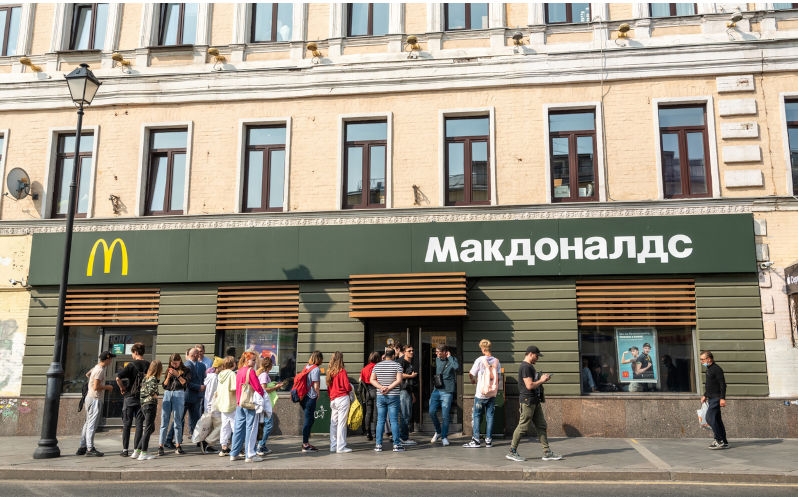Read history, talk peace
July 7, 2024
Russia is not Putin, though you’d hardly know it in current media coverage. Nor is it an autarky. On the contrary, for centuries Russia has interacted with both the East and the West, whose influences have shaped, and confounded, the country’s sense of identity.
The US policy of isolating Russia is not only perpetuating the war in Ukraine, it is also nurturing new alliances between Russia, China and much of the ‘global south’ that threaten to further exacerbate tensions across the world. The New York Times has revealed that the Biden administration blocked progress in Russian-Ukrainian peace talks in 2022. The US is also becoming more embroiled in prosecuting the war; on 23 June 2024, Ukrainian forces fired five US-supplied ATACMS missiles — carrying US-supplied cluster bombs — at the Crimean city of Sevastopol, killing at least four people (including two children) and injuring more than 150.
It is perhaps no coincidence then, that on 25 June, US Secretary of Defence Lloyd Austin telephoned his Russian counterpart, Andrew Belousov. It was the first contact between the defence heads in more than a year and was initiated by Austin. The perfunctory US Department of Defence media release stated the obvious, saying that Austin ‘emphasised the importance of maintaining lines of communication amid Russia’s ongoing war against Ukraine’. It’s about time this happened.
Cutting through the belligerent rhetoric that surrounds commentary on the invasion of Ukraine and shapes current views in the West about Russia is not easy. Historian Darra Goldstein has taken on the task by recounting the history of Russian food. Her The Kingdom of Rye is a slender volume packed with the complexities of Russian history.
Goldstein has Russian heritage and inherited her ancestors’ love of the sour, the salty and the pungent. You can hear her salivating as she talks about rye bread, fermented cabbage, tvorog and smetana (both products of sour milk), though her descriptions of the use of honey in preserving and baking are mouth-watering too. The book starts with rye, since the 11th century the dominant grain in the Russian diet. Black bread has always been a staple. It is nutritious and slow to digest, so it staves of hunger; it is also a sacrament.
The book’s first chapter goes into detail about Russian foods and cooking methods, moving from bread to pies and the introduction of spices from medieval trade routes – Goldstein wants to dispel the notion that Russia has long been disconnected from the world. The story of caviar is related to salt and Ivan the Terrible’s annexation of Siberia in the sixteenth century. The salt-rich Astrakhan region was also the home of the sturgeon, whose roe was salted to become black gold. Russia’s imperial spread to Central Asia and the Caucasus brought warm-climate foodstuffs into the culinary lexicon. Dishes from Georgia and Azerbaijan and Ukrainian dumplings (vareniki) were embraced in Soviet times as part of the ‘brotherhood of all peoples’.
Goldstein’s middle chapter is about hardship and hunger. Russia’s climate, wars and disastrous agricultural polices in Tsarist and Soviet times all caused shortages, and too often famine. She explains how the Russian Orthodox Church codified seasonal patterns of hunger by designating nearly 200 days as fasting (that is no meat) days. She details the desperate measures people took during the Siege of Leningrad, like removing glue from book bindings and scraping wallpaper paste from the walls to retrieve the animal protein these contained.
Having myself lived in Moscow in late Soviet times, the accounts of empty shelves, long food queues, yet also miraculously well-laden tables of Russian friends, ring absolutely true. This paradox can be attributed to two things: the parallel economy of exchange that existed and the centrality of hospitality in Russian culture. Waiting in line for hours, coming together around the kitchen table, foraging for mushrooms and berries, planting potatoes in a tiny plot at the dacha were all activities that helped to retain quintessential Russianness – and sometimes were cover for dissenting conversations − during the Communist period.
Then came MacDonalds! This was not the first encroachment from the West. The aristocracy had embraced many French tastes – and imparted others. Notable is service à la Russe, the habit of serving courses sequentially so that dishes stayed hot, rather than being opulent displays placed in the middle of the table where they got cold. Tea came from China – hence the Russian Caravan blend – in the early nineteenth century and became an essential part of Russian life, carefully brewed atop the samovar. American food aid was sent in by camel in the early 1920s (and again – by plane − in the 1990s); Pepsi arrived in the 1970s.
The Kingdom of Rye contains an important coda on post-Soviet Russia. MacDonalds started a welcome trend of ‘service with a smile’, almost entirely absent in Soviet dining establishments. But then hyperinflation arrived and more tough times for many ordinary Russians, followed by sanctions, which forced Russia to turn to its own supply chain once thousands of products could no longer be imported. What followed has been a revival of interest in traditional practices and cuisine, and, as in other realms of the economy, domestic food outlets have entered the market to replace departing foreign businesses.
These developments are more than tinged with nationalism: Putin has managed to politicise food to fuel his anti-Western ardour. But in telling the history of Russian food, Goldstein offers a much more nuanced tale of Russia’s location in both Europe and Asia. Here is a country that is entwined in what are now global culinary trends, and a people with a ‘national longing for conviviality’. Our leaders would do well to bring Russia back to the table, to talk through our differences while breaking bread.
Darra Goldstein, The Kingdom of Rye, A Brief History of Russian Food, University of California Press, 2022 (paperback 2024)

